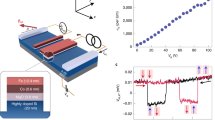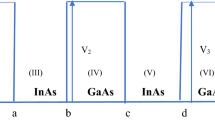We investigated Rashba spin–orbit interaction in various InAs-based heterostructures to evaluate the relative significance of the electric field in the quantum wells (QWs) and at the interfaces. Test structures were designed in such a way that the peak of the electron wave function was located on the abrupt band discontinuity at the front end of the main channel, whereas a control sample had no band discontinuity in the middle of the QW. The Rashba coefficient obtained for the test structures was almost double that of the control sample. Significant contribution of the electric field at the band discontinuity was verified by k · p calculation. Bandgap engineering was shown to be effective for obtaining an increased Rashba coefficient.
Similar content being viewed by others
REFERENCES
S. Datta and B. Das, Appl. Phys. Lett., 56, 665 (1990).
Y.A. Bychkov and E.I. Rashba, J. Phys. C: Solid State Phys., 17, 6039 (1984).
J. Nitta, T. Akazaki, H. Takayanagi and T. Enoki, Phys. Rev. Lett., 78, 1335 (1997).
F.J. Ohkawa and Y. Uemira, J. Phys. Soc. Jpn., 37, 1325 (1974).
G.E. Marques and L.J. Sham, Surf. Sci., 113, 131 (1982).
D. Stein and K.V. Klitzing, Phys. Rev. Lett., 51, 130 (1983).
A. Darr, J.P. Kotthaus, and T. Ando, Proceedings of the 13th International Conference on the Physics of Semiconductors, Rome, Italy 1976, ed. F.G. Fumi (North-Holland, Amsterdam, 1977), p. 774.
R. Winkler, Physica E, 22, 450 (2004).
F. Malcher, G. Lommer, and U. Rossler, Superlatt. Microstruct., 2, 267 (1986).
G.L. Chen, J. Han, T.T. Huang, S. Datta and D.B. Janes, Phys. Rev. B, 47, 4084 (1993).
P. Pfeffer and W. Zawadzki, Phys. Rev. B, 68, 035315 (2003).
E.A. de Andrada e Silva, G. C. Rocca and F. Bassani, Phys. Rev. B, 55, 16293 (1997).
J. Schliemann, J. Carlos Egues and D. Loss, Phys. Rev. Lett., 90, 146801 (2003).
M. Ohno and K. Yoh, Phys. Rev. B 75, 241308R (2007); K.␣Yoh, M. Ferhat, A. Riposan, and J.M. Milunchick, in Physics of Semiconductors, ed. J. Menendez and C.G. Van de Walle, AIP Conf. Proc. No. 772 (Melville, NY: AIP, 2005).
P. Pfeffer and W. Zawadzki, Phys. Rev. B, 59, R5312 (1999).
J. Luo, H. Munekata, F.F. Fang and P.J. Stiles, Phys. Rev. B, 38, 10142 (1988).
G. Dresselhaus, Phys. Rev., 100, 580 (1955).
W. Knap, C. Skierbiszewski, A. Zduniak, E. Litwin-Staszewska, D. Bertho, F. Kobbi, J.L. Robert, G.E. Pikus, F.G. Pikus, S.V. Iordanskii, V. Mosser, K. Zekentes, Yu.B. Lyanda-Geller, Phys. Rev. B 53, 3912 (1996).
D. Grundler, Phys. Rev. Lett. 84, 6074 (2000); S. Sasa, K. Anjiki, T. Yamaguchi, and M. Inoue, Physica B 272, 149 (1999); Y. Sato, T. Kita, S. Gozu, and S. Yamada J. Appl. Phys. 89, 8017 (2001).
ACKNOWLEDGEMENTS
The authors are grateful to Munekazu Ohno for useful discussions. This work was partly supported by a Grant-in-Aid for Scientific Research from the Japanese Ministry of Education, Culture, Sports, Science and Technology.
Author information
Authors and Affiliations
Corresponding author
Rights and permissions
About this article
Cite this article
Matsuda, T., Yoh, K. Enhancement of Spin–Orbit Interaction by Bandgap Engineering in InAs-Based Heterostructures. J. Electron. Mater. 37, 1806–1810 (2008). https://doi.org/10.1007/s11664-008-0559-4
Received:
Accepted:
Published:
Issue Date:
DOI: https://doi.org/10.1007/s11664-008-0559-4




